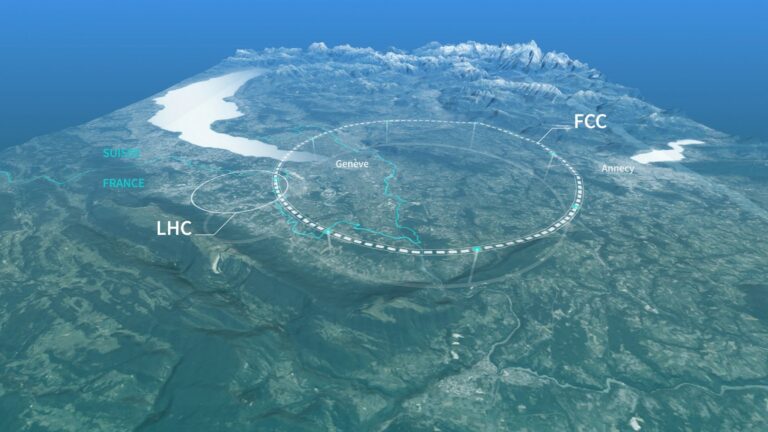CERN Proposes a $17 Billion Particle Collider, Triple the Size of the Large Hadron Collider
Last month, CERN announced its intention to build a $17 billion ring of circular accelerators, 57 miles long, called Future Circular Collider (FCC). The FCC using 100 tera electron volts energy aims to study the dark matter, and dark energy, and asymmetry of matter and antimatter in the universe. The construction could commence with the collider up and running for new particle and forces analysis by 2040s if approved. However, some scientists concern about the high cost for the project and its short term to bring more separation science revolutionary findings.
LHC scientists talk about next step to create larger atom smasher.
The FCC, at 57 miles (91 km), would be much bigger than the current LHC project in CERN near Geneva, which has a length of 16.5 miles (27 km).
Scientists want the new and bigger FCC to provide enough energy to test the limitations of the Standard Model of particle physics, but fails by only a little. By using energies 7 thousand times higher (100 Tera electron volts rather than 14 Tera electron volts in LHC) researchers plan to detect new particles and new forces, discover why there is more matter than antimatter in the universe, understand what happens with dark matter and dark energy that constitutes 95% of the universe. “The FCC will not only deepen our knowledge of the fundamental laws of physics and nature,” said CERN’s director general, Fabiola Gianotti, “it will also stimulate innovation in cryogenics, superconducting magnets, vacuum technologies, detectors & instrumentation suiting society & incurring socioeconomic benefits.”
Current colliders such as LHC use protons and fire them at almost the speed of light, to look for particles that could suggest the prevalence of new forces. This process allows physicists to validate or further develop the Standard Model of physics which, as innovative as it might seem, has several loopholes such as the incapability to explain gravity, presence of dark matter and absence of antimatter in the universe.
In order to minimize these limitations, CERN scientists are now planning on using a seven fold energy increase that is planned to be provided by theFFC to accelerate the particles to even higher velocities.
Nevertheless, among such promising features it is still at the stage of discussion and planning. CERN’s proposals are contained in a feasibility study that should be completed next year. If approved, CERN, which has the support of 18 EU member states, Switzerland, Norway, Serbia, Israel and the UK is likely to seek more funds from the other EU member states.
As for the other critics, few are concerned with the fact that the construction of the collider will cost much. One physicist called me yesterday evening to comment on the article, where he said, “The FCC would be more expensive than both the LHC and LIGO combined, and would have less science reach,” Sabine Hossenfelder, a theoretical physicist.
The fate of the project will be determined after member states sit down in 2028. If given the green light, the first step would be to begin colliding electrons with positrons, or anti-electrons, in 2045, with the proton calculations beginning in the 2070s.
Source: Science
Do not forget to share your opinion with us to provide you with the best posts !




0 Comments